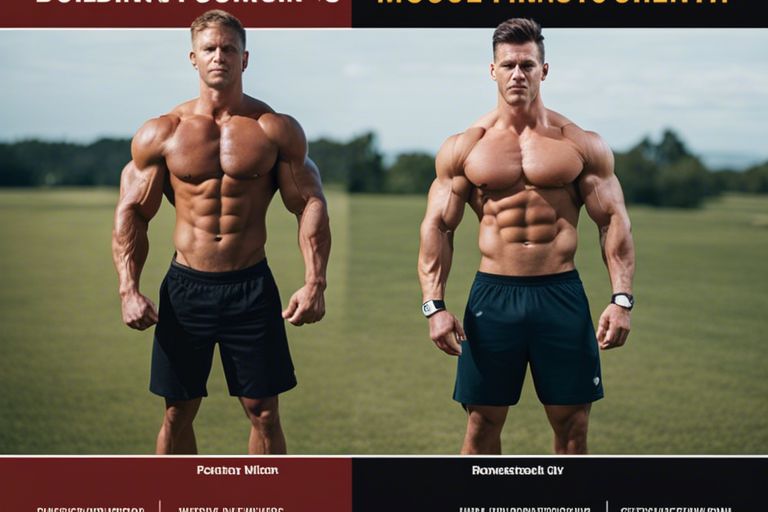
Listen up, champ! You’re about to begin on a journey to uncover the secrets of building muscle and strength. But before you start pumping iron, it’s necessary to understand the difference between these two fitness goals. You see, building muscle and building strength are not one and the same, despite what many gym enthusiasts might claim. In this article, we’ll probe into the science behind each, exploring the distinct mechanisms, training techniques, and outcomes. By the end of this read, you’ll be equipped with the knowledge to create a personalized program that suits your fitness aspirations, whether you’re aiming for bulging biceps or crushing strength.
Key Takeaways:
- Muscle Building focuses on increasing muscle size and hypertrophy through resistance training, nutrition, and supplementation, whereas Strength Building focuses on increasing muscle power and neuromuscular adaptations through specific training methodologies.
- The two goals require different training approaches, with muscle building emphasizing volume and intensity and strength building emphasizing powerlifting and low repetition with high weight. However, both goals share similarities in training approaches and can be combined in a well-designed program.
- Understanding the difference between muscle building and strength building is crucial for achieving individual goals, whether they be aesthetic (muscle mass) or performance-based (strength gains), and for designing a personalized training program that addresses specific needs and objectives.
The Difference Between Muscle Building and Strength Building
The distinction between muscle building and strength building lies in their unique goals, training approaches, and physiological adaptations. Understanding these differences is crucial for you to achieve your specific fitness objectives.
What is Muscle Building?
Muscle mass is built through a process called hypertrophy, where your muscle fibers grow and increase in size. When you engage in muscle-building exercises, you’re imperatively challenging your muscles to adapt to the demands placed upon them. As a result, your body responds by building more muscle tissue to meet those demands.
What is Strength Building?
On the other hand, strength building focuses on developing your ability to generate force and power. It’s about improving your neuromuscular connection, allowing your muscles to contract more efficiently and effectively.
Building strength requires a different approach than building muscle. You see, when you’re strength training, you’re not just building muscle size, but also improving your central nervous system’s ability to recruit muscle fibers and generate force. This means you’ll be able to lift heavier weights and perform more intense exercises, even if your muscle size doesn’t necessarily increase.
The Science Behind Muscle Building
Little do you know, building muscle is a complex process that involves multiple physiological mechanisms. To understand how to build muscle effectively, it’s vital to grasp the underlying science.
How Muscle Growth Occurs
An increase in muscle mass occurs when your body builds new muscle proteins at a rate that exceeds the breakdown of existing proteins. This process is triggered by muscle damage, inflammation, and metabolic stress, which activates various cellular signaling pathways that stimulate muscle protein synthesis.
The Role of Nutrition and Supplements
One of the most critical factors in muscle building is adequate nutrition. You need to consume sufficient protein to provide your body with the necessary building blocks for muscle growth. Additionally, supplements like creatine and protein powder can help support your muscle-building efforts.
Nutrition plays a vital role in muscle building, as it provides the necessary energy and nutrients for muscle growth and repair. A diet rich in protein, carbohydrates, and healthy fats is vital for supporting muscle protein synthesis and promoting muscle growth.
Muscle Fiber Types and Their Impact
Fiber type distribution is a critical factor in determining your muscle-building potential. You have two main types of muscle fibers: slow-twitch (Type I) and fast-twitch (Type II). Type II fibers are more responsive to muscle-building stimuli, whereas Type I fibers are more resistant to fatigue.
Science suggests that your muscle fiber type distribution plays a significant role in your muscle-building potential. Here’s a breakdown of the different muscle fiber types and their characteristics:
| Fiber Type | Characteristics |
| Type I (Slow-Twitch) | High endurance, low force production |
| Type IIa (Fast-Twitch Oxidative) | High force production, moderate endurance |
| Type IIb (Fast-Twitch Glycolytic) | Very high force production, low endurance |
| Type IIx (Fast-Twitch Intermediate) | High force production, moderate endurance |
Any successful muscle-building program should take into account your individual muscle fiber type distribution and tailor your training and nutrition accordingly.
- Type II fibers are more responsive to high-intensity training and require adequate protein intake to support growth.
- Type I fibers are more resistant to fatigue and require endurance-based training to improve their function.
Any well-structured muscle-building program should consider the role of muscle fiber types in determining your training and nutrition strategy.
The Science Behind Strength Building
Now that we’ve covered the basics of muscle building, it’s time to look into the science behind strength building. Understanding the underlying mechanisms will help you optimize your training and achieve your strength goals.
How Strength is Developed
Scientifically speaking, strength is developed through a combination of muscle fiber recruitment, neuromuscular adaptations, and central nervous system (CNS) signaling. When you challenge your muscles with progressive overload, they adapt by increasing their strength and endurance.
The Importance of Neuromuscular Adaptations
Developed through repeated practice and training, neuromuscular adaptations play a crucial role in strength building. These adaptations enable your muscles to work more efficiently, allowing you to generate greater force and power.
The more you train, the more your nervous system learns to recruit muscle fibers effectively, leading to increased strength gains. This is why consistent practice and progressive overload are imperative for continued strength development.
Central Nervous System Role in Strength
Strength is not just about muscle size; it’s also about the ability of your CNS to coordinate and control muscle movements. As you train, your CNS adapts by improving its signaling efficiency, allowing you to lift heavier weights and perform complex movements with greater precision.
Adaptations in the CNS enable you to develop greater strength by increasing the number of motor units activated, improving muscle fiber recruitment patterns, and enhancing overall neuromuscular efficiency. This is why strength training should always involve a combination of physical practice and mental focus.
Training for Muscle Building
All aspiring bodybuilders and fitness enthusiasts know that building muscle requires a well-structured training program. To achieve significant muscle growth, you need to focus on specific training methods that stimulate muscle hypertrophy.
Effective Resistance Training Methods
Muscle growth is induced by subjecting your muscles to progressive resistance exercises. This can be achieved through various resistance training methods, including free weights, resistance bands, and machines. The key is to choose exercises that work multiple muscle groups at once, such as squats, deadlifts, and bench press.
Volume and Intensity Strategies
Training with high volume and intensity is crucial for building muscle. This involves performing a higher number of sets and reps with heavier weights, which stimulates muscle growth and strength gains.
Plus, incorporating techniques like rest-pause, blood flow restriction, and eccentric training can further enhance muscle growth by increasing time under tension and metabolic stress.
Progressive Overload Techniques
For muscle growth to occur, you need to challenge your muscles by gradually increasing the weight or resistance over time. This is known as progressive overload, which can be achieved through methods like weight progression, rep range manipulation, and exercise variation.
For instance, if you’re doing 3 sets of 8 reps of bench press with 100 pounds, aim to increase the weight to 105 pounds or more over time to continue challenging your muscles and promoting growth.

Training for Strength Building
Keep in mind that strength building requires a different approach than muscle building. When training for strength, you’re focusing on developing your neuromuscular system’s ability to generate force, rather than just increasing muscle size.
Powerlifting and Olympic Lifting Techniques
Strengthening your muscles through powerlifting and Olympic lifting techniques is vital for building overall strength. These exercises, such as squats, deadlifts, and bench press, work multiple muscle groups at once, allowing you to lift heavier weights and develop explosive power.
Low Repetition and High Weight Training
Strengthening your muscles also requires low repetition and high weight training. This type of training focuses on lifting heavy weights for fewer reps, typically in the 1-5 rep range, to build strength and power.
This type of training is effective because it allows you to overload your muscles, causing them to adapt and become stronger. By lifting heavy weights, you’re challenging your muscles to generate more force, which leads to increased strength gains.
Periodization Strategies for Strength
Training with periodization strategies is crucial for continued strength gains. This involves varying your training program over time to avoid plateaus and ensure progressive overload.
Periodization involves alternating between periods of intense training and lighter training, allowing your muscles to recover and rebuild. This strategy helps prevent overtraining and ensures that you continue to make strength gains over time.
Final Words
Presently, you’ve reached the end of this informative journey, and by now, you should have a clear understanding of the difference between building muscle and building strength. Recall, your fitness goals are unique, and it’s important to tailor your training program accordingly. Don’t be afraid to experiment and combine techniques to achieve your desired outcome. As you continue on your fitness path, keep in mind that knowledge is power, and staying informed will help you reach new heights. So, go ahead, eat proper meal, lift heavy, and lift smart, take right supplement – your body will thank you!
FAQ
Q: What is the main difference between building muscle and building strength?
A: The main difference between building muscle and building strength lies in their distinct goals and training approaches. Building muscle, also known as hypertrophy, focuses on increasing muscle size and endurance through higher volume and intensity resistance training, whereas building strength emphasizes developing power and force through low-repetition, high-weight exercises that target neuromuscular adaptations. While there is some overlap between the two, understanding the differences is crucial for achieving specific fitness goals.
Q: Can you build muscle without building strength, and vice versa?
A: Yes, it is possible to build muscle without building strength, and vice versa. For example, a bodybuilder may focus on high-volume, high-intensity training to increase muscle size, but not necessarily prioritize strength gains. On the other hand, a powerlifter may focus on building strength through low-repetition, high-weight exercises, but not necessarily prioritize muscle growth. However, it’s worth noting that building muscle can contribute to increased strength, and building strength can contribute to increased muscle mass. A well-rounded training program can incorporate elements of both to achieve overall fitness goals.
Q: Is it better to focus on building muscle or building strength, and why?
A: The answer depends on your individual fitness goals and priorities. If you’re looking to improve athletic performance, enhance overall functional ability, or simply feel more confident in your daily life, building strength may be the better focus. On the other hand, if you’re looking to improve aesthetics, increase muscle endurance, or enhance overall muscle development, building muscle may be the better focus. Ultimately, a balanced training program that incorporates elements of both can provide the most comprehensive fitness benefits. It’s important to assess your individual goals and needs to determine the best approach for you.




